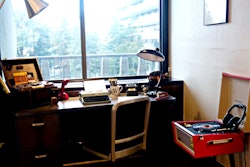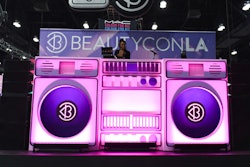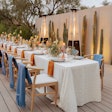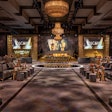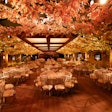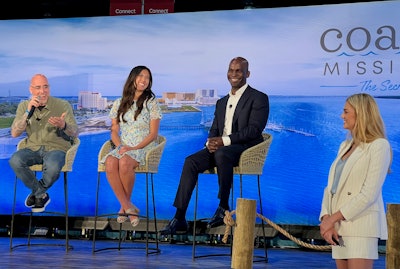
Missed the IRL panel discussion at Connect Spring Marketplace in Puerto Rico? Join us in Detroit for more. Register to attend IRL here, and virtually here.
BizBash welcomed four masterminds of event design to the stage during its Connect Spring Marketplace event in San Juan, Puerto Rico, May 22-24—Andrew Roby, the corporate event planner at Andrew Roby Events; Lilian Shen, the director of marketing at CORT Events; Cliff Rigano, the head of culture, content, and experiential at Mast-Jägermeister US; and Jack Bedwani (who streamed in virtually), the CEO of New Moon.
And as Shen said during the panel discussion, event professionals are “in an industry of go, go, go,” filled with hustlers who “want to do anything and everything.”
But when thinking about going beyond event design—to what Bedwani referred to as “experience design”—it’s important to find moments of “reprieve or reflection.” And while the CEO was referring to guests being able to find a moment of pause during their experience, we’re suggesting planners do the same in this moment—to take a pause from, well, everything, to read more not only about the importance of juxtaposing wow-worthy, Instagrammable elements with bits of reprieve, but also about how to take event design into something interactive, how to navigate budget restrictions, determine ROIs and KPIs, and much more.
When it comes to event design, how do you gauge how much creative liberty to take? When looking to save money, Roby suggests implementing certain experiential elements virtually, sharing that he likes to pinpoint what the client wants guests to take away from the event and "work your budget toward that."Screenshot Courtesy of akire productions
When looking to save money, Roby suggests implementing certain experiential elements virtually, sharing that he likes to pinpoint what the client wants guests to take away from the event and "work your budget toward that."Screenshot Courtesy of akire productions
Andrew Roby: I think it just depends. It depends on the client because some clients just have no clue how to create design. A lot of us, we struggle trying to figure out what we’re wearing each and every day, so trying to figure out how a room looks or how to get sponsors integrated into a design package really depends on if they’ve done this particular type of event before, or if they have experience with design, design elements, integration, and experiences of attendees.
And if they don’t, then I try to take full control of trying to create that design because a lot of times people think, “Oh well, this is just a sponsor or a client event, it doesn’t matter.” But it’s our name that’s tied to it as well, so we want to make sure that it looks good and that it feels good. So if they don’t have that experience then I’m taking control of it.
How can you go beyond inanimate decor and include something interactive for guests to enhance their experience?
Jack Bedwani: The key is going beyond event design and thinking about experience design. And the real thing about that—the thing that strings everything together—is how you make someone feel. The guest experience doesn’t necessarily start at the front door, for example. In most cases, it should start well before then. The first moment that a guest should feel something is when the invitation lands. When thinking about the pre-event strategy, give guests that sense of anticipation or excitement. What are the ways that you can start getting them really jazzed and excited to show up at your event? Set the tone before they even walk through the front door.
At the actual event, it’s about creating amazing moments and lasting memories, and really trying to pull those levers to make guests feel something. Like any great book or film, it’s very much about creating a story arc. And the interesting thing about that is that yes, there should be peaks throughout the experience—moments of grandeur and visceral, loud excitement—but also moments of pause and, perhaps, a little moment of reprieve or reflection. But the great thing is that it doesn’t have to be literal or linear. Some event experiences happen in a very logical, moment-to-moment, straight-down-the-line format. But in others, it can be more of a “choose your own adventure,” where there are multiple rooms and different guests are experiencing things at different times.
 Bedwani suggested that "the key [to] going beyond event design [is] thinking about experience design," and cited a recent event New Moon produced for Pandora at Coachella where there was a piercing station among all the festival's "chaos."Screenshot Courtesy of akire productions
Bedwani suggested that "the key [to] going beyond event design [is] thinking about experience design," and cited a recent event New Moon produced for Pandora at Coachella where there was a piercing station among all the festival's "chaos."Screenshot Courtesy of akire productions
And so I think when you’re creating memories it doesn’t necessarily need to always be in the music video moment that was the best, highest, most amazing part of the show, but more in that thing that guests can take with them going forward.
How do you balance creating out-of-the-box experiential moments while managing a client’s expectations? What budget limitations come into play and when is “no” the right answer?
Cliff Rigano: What I would say is this—there is no limit to creativity, and wild, out-of-the-box ideas are generally what’s going to push things forward. We live in a world where the only advantage we really have is the first-mover advantage. Everyone can spend more, everyone has a bigger staff, everyone has more time, but if you can do something first, you should always try to rely on that.
And you never necessarily tell the client it can’t be done, but the most important thing that you could ever do is tie it back to the brief. Tie it back to the reason why you’re all here. Don’t be the bearer of bad news, just always point back to the original ask and say, “But this is what you asked me to do, and this might not be the most effective way to do it.”
AR: At the beginning stages of talking about what that run of show looks like—what the experience looks like—we have to set the proper expectations. I can only do so much with $20,000; I can do a whole lot with $2 million. And I think that when we come down to it, ask, “What is the result? What is the feeling you want someone to have when they leave your event? What do you want them to really talk about to their friends and to their audience, and share on social media?” Pinpoint what that is and work your budget toward that. Everything else is a compromise.  Rigano believes event design is important when telling a "secondary story." In his role at Mast-Jägermeister US as the head of culture, content, and experiential, Rigano implements design to teach guests more about the brand's story, including that Jägermeister was created in 1878, is made with 56 ingredients, and goes through 383 quality checks.Screenshot Courtesy of akire productions
Rigano believes event design is important when telling a "secondary story." In his role at Mast-Jägermeister US as the head of culture, content, and experiential, Rigano implements design to teach guests more about the brand's story, including that Jägermeister was created in 1878, is made with 56 ingredients, and goes through 383 quality checks.Screenshot Courtesy of akire productions
There are other things that you can do—maybe something you can’t implement at the event, but you can spend a little less on and implement that virtually. There are so many things to focus on, so while I can’t say that I’m going to get everything with a $2,000 budget, I will focus on what the client really wants their audience to get out of it and go from there.
How does event design affect ROI? Is there ever an instance where event design could hurt your ROI?
Lilian Shen: That’s a loaded question. Everyone’s investment—every return that you’re seeking—is unique to each situation. So it’s about sitting down and analyzing what exactly you’re trying to accomplish. And then, of course, there’s ROI versus ROE. Are you trying to get a return on investment—your dollars—or are you trying to get a return on engagement?
For me, personally, when it comes to event design, I think a lot about whether I’m trying to get folks to engage at the event, or after the event. A lot of times, those things will conflict. We design a lot for these Instagrammable, TikTok moments, but are folks so absorbed in waiting in line for this beautiful selfie station, that they’re not actually immersing themselves into the experience? Make sure you’re taking that step back to look at the bigger picture by putting yourself in the attendee journey to figure out: How would I behave if I were to enter the space as a certain demographic or a different culture that may be attending this event? Thinking about all of this will affect your design and, honestly, if you don’t, you’re going to keep doing the same thing over and over again, and you’re not going to see improvement. We’re in an industry of go, go, go, so for those of you who do repeat events every year, it’s easy to say, “Hey, it worked, that’s great.” I think the hardest part is to cut that cycle, take a step back, and dedicate time to look at each of those aspects.
How do you make guests seeing an event on social media part of the experience?
JB: It’s one of the million-dollar questions in our industry today. For me, it’s one that I think about quite a lot because our industry entirely has changed in the last decade in a really profound way. Prior to social media, we designed incredible experiences for people in the room, and that was the job. Then, social media came around, and now we’re in two markets—the person in the room and the person that’s on social media. The experience is really different.
I think that most clients expect you to do both today, but it’s really about understanding priorities. Is it about ROI? Is it about return on engagement? What are the KPIs? And mostly, I think it’s about serving the room first, because that’s the place where the content is actually being created. If you don’t serve the room first, you risk creating an experience that falls short and then that being the message out on social media. We’ve seen that in recent years—the Fyre Festival was a really big example of that.
How can an overall event design either completely enhance or completely botch an experience? Shen said it's important for planners to differentiate whether they are measuring ROIs or ROEs in order to determine if you want more dollars or more engagement. If it's engagement, be sure to consider whether you want guests to engage at or after the event.Screenshot Courtesy of akire productions
Shen said it's important for planners to differentiate whether they are measuring ROIs or ROEs in order to determine if you want more dollars or more engagement. If it's engagement, be sure to consider whether you want guests to engage at or after the event.Screenshot Courtesy of akire productions
CR: Generally, events try to tell a story and engage an audience. Design can help you tell a secondary story to that audience at the same time. For example, you may know Jägermeister, and you may know Jägermeister as one specific beverage with one specific method of drinking it. But what you don’t necessarily know about Jägermeister is that it was created in 1878, there’s 56 ingredients, it ages for a year in old barrels, it goes through 383 quality checks, and it’s the same bottle design that was made from the beginning.
But you wouldn’t know that at the event that we throw, because when we’re at the event, I’m just telling you one very specific thing. Design can help tell that story in ways that an event maybe can’t. And as you are standing with your drink, enjoying it, you’re looking at the environment, and it’s not an activation as much as it is an experience. Design can play an intimate and intricate role in delivering information to your attendees in a way that maybe they weren’t expecting either.
No matter what event you’re planning, what’s an event design must-have?
LS: Mine would probably be intention. I’m personally a really big psychology nerd, so I approach everything with that emotional intelligence pathway to figure out what my attendees are expecting, then how do I make them not expect it? What are we trying to get them to, and what is the path?
For a tangible must-have, my favorite thing is something that’s a little bit of a reveal. You don’t want your attendees to walk into a room and see everything in the first five seconds. You want them to go through some kind of realization or discovery in that event process. Build that into the guest experience and allow them the autonomy to discover what fills that “aha” moment, which they will take away. It’s like a speakeasy—discovering this amazing thing that I don’t know if anybody else has seen yet, but I’m going to go tell other people there’s this other feature to look at and play around with at the event.
AR: My answer is nothing, honestly. I try not to replicate a design, and specifically something that I see over and over again i.e. photo booths and 360 video booths. They’re great, but I try to integrate things that people will say, “I would’ve never thought to do this.”
JB: Someone on my team that cares about that project more than anybody else. Because when we’re busy, and there’s a lot going on, and we’re spinning a lot of plates, you risk mediocrity if there’s no one that is an absolute champion really pushing to do better, to go further, to make that budget go further, and just to get people’s attention. Having that champion really sets you up to create something special.
This interview has been edited and condensed.





